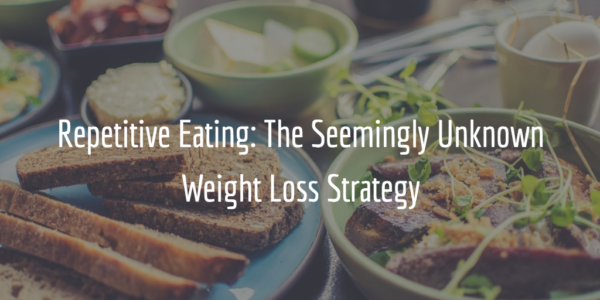When I was growing up, I specifically remember my mom trying to figure out what we would have for dinner every night. It always seemed like a chore for her because she got up early, worked long days, and had to pick up my brother and I after soccer practice.
I’m sure, the last thing she wanted to do was think about what ingredients she needed and how much preparation would be involved. And I’m also sure it was hard each week to figure out what our family would like to eat and hadn’t had in a while.
Because the majority of people crave variety. We don’t like doing the same thing over and over again. We feel this need to constantly spice things up, but that’s often what gets us into trouble.
Did you know, on average, a grocery store will carry over 39,000 different items? 39,000! Though variety has been touted as the spice of life, this vast amount of food variety has played a role in overconsumption in our society.
While research is still emerging, there have been several interesting studies conducted on food variety and how it affects us.
One interesting experiment was done with M & Ms candies. The researchers wanted to see what would happen if they gave moviegoers more color choices. They found that those who were given 10 different colors ate 43% more than those who were given the same amount of M & Ms in 7 colors.
Another study in France offered two options of french fries to participants to see which one they ate more of. The first had no condiments while the second had ketchup and mayonnaise as a side. The researchers found the participants ate more when the fries were paired with condiments.
Barbara Rolls, the director of Laboratory for the Study of Human Ingestive Behavior at Penn State University, has termed this as the “buffet effect”. Her team has found that pleasure from food decreases while eating. So if a meal offers other tastes, smell, textures, or colors people tend to switch to another food item. This is why if you go to a buffet-style restaurant you’ll typically eat more.
Current research is showing that similar meals each week (repetitive eating) help decrease caloric intake.
One study for instance had 1 group of non-obese women and 1 group of obese women randomly assigned to 1 of 2 groups. Each group was given a computer task to accomplish and were rewarded with macaroni and cheese when they completed it.
One group completed one session every day for five days. So they received macaroni and cheese 5 days back-to-back. The other group completed one session each week for five weeks. So they received the macaroni meal one time per week for five weeks. The researchers found that those who received the food daily consumed less calories than the group given the food 1 time per week (1).
Another study looked at how food variety affected 2,237 participants who had lost an average weight of 70.9 pounds and maintained a weight loss of at least 30 pounds for an average of 6 years. The research team had participants complete food frequency questionnaires that examined the amount of variety in different food groups. They found those most successful with maintaining weight loss consumed a diet with limited variety in all food groups (2).
So, what does all of this tell us?
Well, let me start off by saying that I’m not implying you should have a limited diet. Consuming a well-rounded diet full of all types of food groups (fruits, vegetables, meat, grains, etc.) is a great way to ensure you’re getting plenty of nutrients to stay healthy.
What this information does tell us is that the less you have to think about your food and the more consistent it is, you’ll be less likely to overeat and be more successful with maintaining your weight loss. But this isn’t a suggestion to eat only one thing for the rest of your life.
It means having similar meals each day not exactly the same meal. By doing this it becomes one less thing you have to worry about. Let me show you what I mean with a template.
| Male | Female |
|---|---|
| 2 palm size servings of protein | 1 palm size serving of protein |
| 2 fist sized servings of veggies | 1 fist sized serving of veggies |
| 2 cupped hand size servings of carbs | 1 cupped hand size servings of carbs |
| 1-2 thumb sized servings of fat | 1 thumb sized serving of fat |
Using this template, you could create a meal in minutes and have it for multiple days in a row. And it offers a good balance of protein, carbohydrates, and fat. Here are some example meals.
For lunch, you could have a chicken breast, 1 fist sized portion of carrots, 1 cupped hand of blueberries, and 1 thumb sized serving of almonds. You could make this over a weekend and have it several days in a row.
For dinner, you could have 1 steak cooked in 1 thumb sized portion of olive oil, 1 fist sized serving of broccoli, and 1 small sweet potato. Again, you could make this on a weekend and have it for a few nights.
With both meals, the only thing you would have to cook is the meat. The veggies could be eaten raw or you could buy them frozen and heat them up in the microwave. And there’s no preparation needed for the fruit or fats.
If you get tired of these meals, simply switch it up with a new food in each category. It’s as easy as that!
Variety isn’t all it’s cracked up to be when your goal is weight loss. You get nothing from it but headaches and worry as you try to figure out what to eat on a day by day basis.
One simple solution is to use this repetitive eating method. It may be boring, but it’s also extremely effective at helping you limit calories, lose weight, and be worry free.
With the stress of life, it’s hard to keep proper nutrition at the forefront of your mind. But using this repetitive eating strategy can make all the difference. It takes the work out of eating well, so you can devote more time to other areas in your life.
So, if you are struggling to lose weight and aren’t sure why, you may just have access to too much variety. Limit your choices and you’ll find that it becomes much easier to eat healthy and change the way your body looks.
References:
1. Epstein, LH. et al. Long-term habituation to food in obese and nonobese women. Am J Clin Nutr. 2011 Aug;94(2):371-6.
2. Raynor HA, et al. Amount Of Food Group Variety Consumed In The Diet And Long-Term Weight Loss Maintenance. Obes Res. 2005 May;13(5):883-90.






